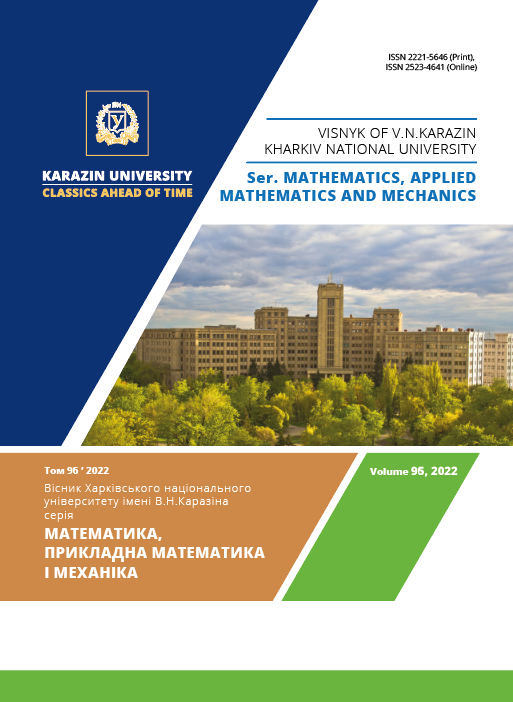The explicit form of the switching surface in admissible synthesis problem
Abstract
In this article we consider the problem related to positional synthesis and controllability function method and more precisely to admissible maximum principle. Unlike the more common approach the admissible maximum principle method gives discontinuous solutions to the positional synthesis problem. Let us consider the canonical system of linear equations $\dot{x}_i=x_{i+1}, i=\overline{1,n-1}, \dot{x}_n=u$ with constraints $|u| \le d$. The problem for an arbitrary linear system $\dot{x} = A x + b u$ can be simplified to this problem for the canonical system. A controllability function $\Theta(x)$ is given as a unique positive solution of some equation $\Phi(x,\Theta) = 0$. The control is chosen to minimize derivative of the function $\Theta(x)$ and can be written as $u(x) = -d \text{ sign}(s(x,\Theta(x)))$. The set of points $s(x,\Theta(x)) = 0$ is called the switching surface, and it determines the points where control changes its sign. Normally it \mbox{contains} the variable $\Theta$ which is given implicitly as the solution of equation $\Phi(x, \Theta) = 0$. Our aim in this paper is to find a representation of the switching surface that does not depend on the function $\Theta(x)$. We call this representation the explicit form. In our case the expressions $\Phi(x, \Theta)$ and $s(x, \Theta)$ are both polynomials with respect to $\Theta$, so this problem is related to the problem of finding conditions when two polynomials have a common positive root. Earlier the solution for the 2-dimensional case was known. But during the exploration it was found out that for systems of higher dimensions there exist certain difficulties. In this article the switching surface for the three dimensional case is presented and researched. It is shown that this switching surface is a sliding surface (according to Filippov's definition). Also the other ways of constructing the switching surface using the interpolation and approximation are proposed and used for finding the trajectories of concrete points.Downloads
References
A.M. Lyapunov, The General Problem of the Stability of Motion. - 1892. Kharkov Mathematical Society, Kharkov. English translation: The general problem of the stability of motion (trans. A.T. Fuller), in International Journal of Control, 55:3, 531-573. 1992 DOI: https://doi.org/10.1080/00207179208934253
L. S. Pontryagin, V. G. Boltyanskii, R. V. Gamkrelidze, E. F. Mishechenko, The Mathematical Theory of Optimal Processes. VIII + 360 S. New York/London 1962. John Wiley & Sons. Preis 90/-. DOI: https://doi.org/10.1002/zamm.19630431023
R. Kalman, Y. Ho, K. Narendra, Controllability of linear dynamical systems. Contributions to Differential Equations 1. - 1963, 189-213.
V. I. Korobov. A general approach to the solution of the bounded control synthesis problem in a controllability problem, Math. USSR Sb. 37. - 1980. - No. {bf 4}, 535-557. DOI: https://doi.org/10.1070/SM1980v037n04ABEH002094
V. I. Korobov, G. M. Sklyar. Time optimality and the power moment problem. Mat. Sb., Nov. Ser. 134(176). - 1987. no. 2(10), 186-206; Math. USSR, Sb. 62. - 1989. No. 1, 185-206. DOI: https://doi.org/10.1070/SM1989v062n01ABEH003235
V. I. Korobov, G. M. Sklyar. Methods for constructing of positional controls and an admissible maximum principle, Differ. Equations 26 (1990), Vol. 11, 1422-1431.
V.I. Korobov, Method of controllability function, R$&$C Dynamics, Moskow-Ijevsk, 2007. ISBN 978-5-93972-610-8.
A. F. Filippov, Differential equations with discontinuous right-hand side, Mat. Sb. (N.S.), 51(93):1 (1960), 99-128.
The copyright holder is the author.
Authors who publish with this journal agree to the following terms:
1. Authors retain copyright and grant the journal right of first publication with the work simultaneously licensed under a Creative Commons Attribution License that allows others to share the work with an acknowledgement of the work's authorship and initial publication in this journal. (Attribution-Noncommercial-No Derivative Works licence).
2. Authors are able to enter into separate, additional contractual arrangements for the non-exclusive distribution of the journal's published version of the work (e.g., post it to an institutional repository or publish it in a book), with an acknowledgement of its initial publication in this journal.
3. Authors are permitted and encouraged to post their work online (e.g., in institutional repositories or on their website) prior to and during the submission process, as it can lead to productive exchanges, as well as earlier and greater citation of published work (see The Effect of Open Access).




